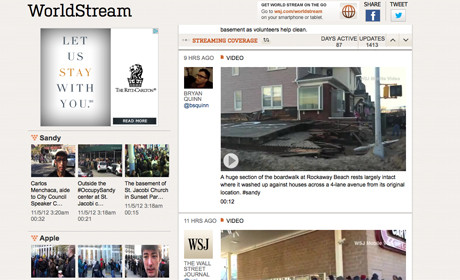
Sandy video clips on WorldStream
It had only been around two months since the Wall Street Journal launched WorldStream, its video liveblog which features footage captured by its reporters on their mobile devices, when Hurricane Sandy struck.
WSJ reporters can use an iPhone and Android app to upload short video clips to the stream, with reporters having been trained in how to shoot video on smartphones in a bid to remove any barriers for journalists not multimedia trained.
So as Hurricane Sandy struck late last month, this training was swiftly put into practice. Editor of WorldStream and real-time deputy editor of video Mark Scheffler told Journalism.co.uk that "a big news event like this is a great showcase for the platform".
Around 250 Sandy clips were submitted to WorldStream, filmed by roughly 50 journalists across seven states. And in the first 24 hours of Sandy the site "had nearly double the overall page views than we would normally expect for a Monday, including significant video views I know as well", Scheffler said. WorldStream coverage of the hurricane is collected on the platform by tags.
WSJ had reporters "filing from everywhere that was affected by the weather", and thanks to the new WorldStream platform the Journal's coverage was complemented by "this visual video stream of dispatches from all these affected areas coming in on a pretty constant, or near constant, basis".
"It was a good way to take advantage of all the places that we had reporters. They were all writing stories as well, they were tweeting, they were taking photos in some cases, but we also really wanted them to focus on video too."
The mobile element of the platform meant content could be submitted despite the impacts on travel. Scheffler said that reporters were generally able to use their smartphones and the app to submit content to the platform, while in some cases footage was emailed over instead.
"There were a few issues where things took longer than usual just because 4G service around the city was a little spotty at times, but for the most part people got their content up really soon after shooting it, which is the whole idea behind it in general."
WorldStream also helped to engage even more of WSJ's reporters, some of whom had not yet produced video for the platform, with video production.
"About 25 per cent of the people who were contributing had contributed to the stream before, but then we had 75 per cent were all new to the platform and so I think they'll be better shooters next time.
"When you come in to the video world from the text world there's a learning curve there ... so it was a good opportunity to get reporters into the pipeline and into the system and experimenting with what worked and what didn't work."
He added that the idea is to lower any barriers to video production for journalists interested in becoming "full-fledged, multimedia reporters".
"Getting audio and tweeting is one thing, but one of the barriers for print reporters is [that] producing video is hard, especially if you want to cut a package together and there's a lot of workflow involved and sometimes you need to write a script.
"So with this platform reporters are able to participate in being video journalists. It really makes it much easier to do that. We have reporters talking to the camera from scenes of the flood, they're talking over footage, and it gives them a visceral and really immediate way to convey the things that they're seeing.
"And literally to shoot something and send it, and for us to publish it that all can happen in like a 10 minute swing, and it's exciting for them to see their stuff going up all over the site within a matter of minutes."
For now, the focus is on building on this video participation, he added.
"Right now my interest is mostly just in having the reporters participate and having them see the huge advantages that it can give them as reporters and the huge advantage it conveys for readers and viewers who get to see these reporters that they read out in the field.
"This is somewhat of an anti-broadcast model, it's a lot more guerilla in nature, it's raw. That's fine because we present it as reporter-shot smartphone footage so people come in with the expectation that this is going to be a visceral ... experience.
"We always want them to be improving too. But the fact is that a lot of the times reporters are holding their cameras out with their outstretched arm in front of them. And I like that, we think that it's an exciting way to get them to tell us what they're seeing."
Free daily newsletter
If you like our news and feature articles, you can sign up to receive our free daily (Mon-Fri) email newsletter (mobile friendly).









